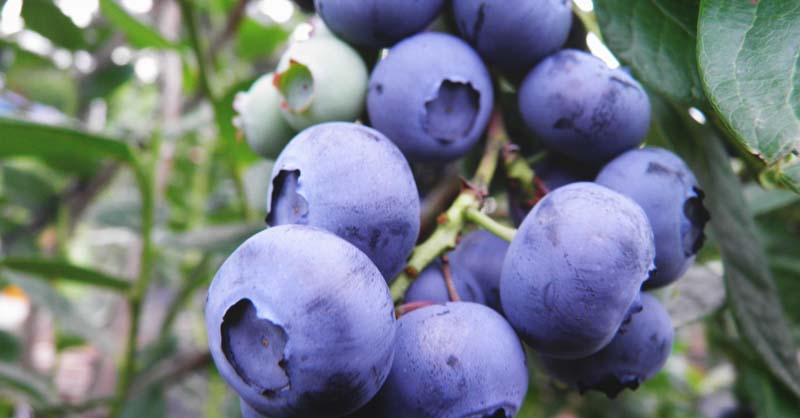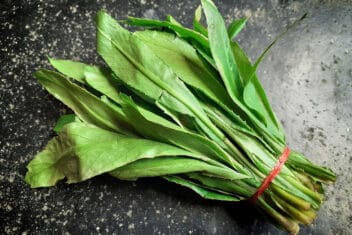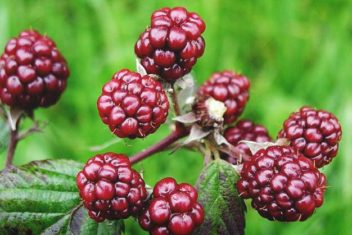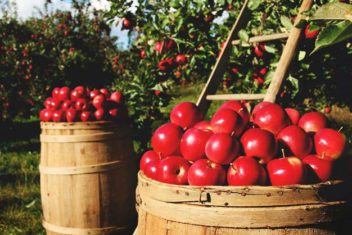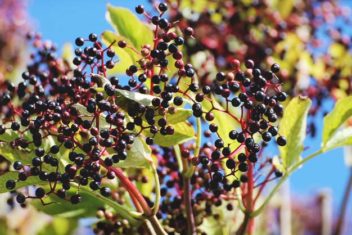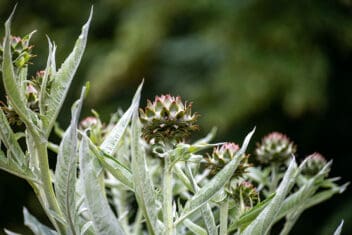One of my favorite childhood food memories involves blueberries. I remember my grandmother making a delicious cheesecake topped with the juicy fruits.
While they aren’t the easiest plants to grow, fresh berries off the plant are out of this world. Plus, once you get them established, they aren’t too hard to maintain.
Looking to grow these tasty fruits in your garden? Here’s all you need to know about growing blueberries:

Blueberry Plant Info
- Hardiness Zones: 3-7 or 7-9 depending on the variety
- Soil: Heavy clay, loam, sandy, PH between 4 to 4.8, well-drained, fertile, rich in organic matter
- Sun Exposure: Full sun
- Planting: Early in spring
- Spacing: 4 to 5 feet between plants and 8 to 9 feet between rows
- Depth: 9 to 10 inches, 1 inch deeper than they were in the nursery
- Best Companions: Oak, pine, basil, thyme, grape, hyacinth
- Worst Companions: Cabbage, pumpkin, spinach, potato, tomato, cucumber
- Watering: Water regularly and deeply, 1 to 2 inches per week
- Fertilizing: Apply all-purpose fertilizer 1 year after planting and every year thereafter
- Common Problems: botrytis blossom rot, mummy berry, powdery mildew, shoestring, stem canker, phytophthora root rot, blueberry bud mite, flea beetle, Japanese beetle, sharp-nosed leafhopper, thrips
- Harvest: 3 to 6 years after planting, pick the berries in late July to mid-August
Best Blueberry Varieties to Plant
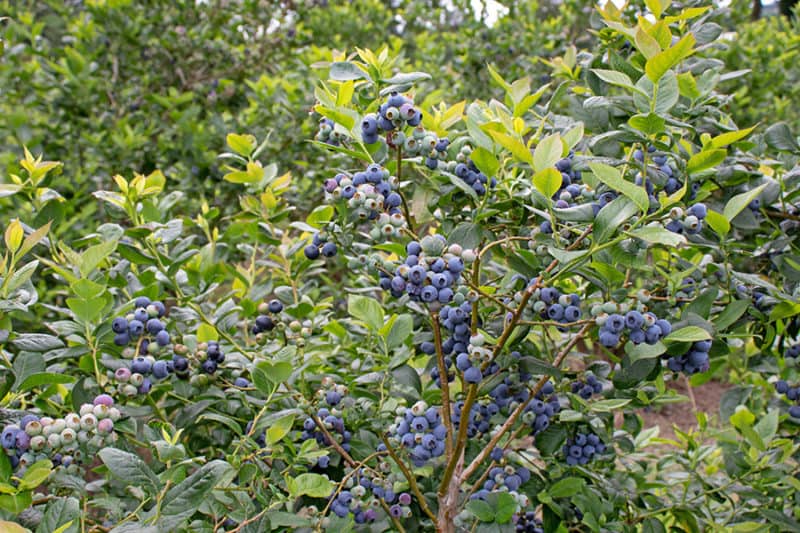
There are five main varieties of blueberries with different cultivars that branch off of those varieties. Here are the varieties of blueberries you can choose from, along with some of the cultivars.
Lowbush
Lowbush, Vaccinium angustifolium, is short in stature for a blueberry bush. They’re often what people use when they live with strict HOA’s but would like to have an ornamental bush that they can get something edible from.
Also known as wild blueberry, people use this type of variety in container gardening as well. It’s also low-maintenance as it doesn’t require much pruning.
It grows best in USDA zones 3-7. Check out:
- Chippewa
- Northblue
- Polaris
Northern Highbush
Northern highbush, Vaccinium corymbosum, is a taller plant. This style of bush grows to be about 5-9 feet tall. This variety of blueberries was designed to grow in the Eastern and Northeastern United States.
They require consistent pruning and grow best in USDA zones 4-7.
A few options for this variety are:
- Bluecrop
- Duke
- Legacy
- Hardyblue
Southern Highbush
Southern highbush, Vaccinium angustifolium, was designed to grow in southern climates that have a mild winter season, such as Florida.
This bush will grow to a decent size of 6-8 feet tall. They grow in up to USDA zone 10.
A few options for this variety are:
- Misty
- Sharpblue
- Sunshine Blue
Rabbit Eye Blueberries
The Rabbit Eye variety, Vaccinium ashei, was designed to produce in the Southeastern U.S. These blueberries do best where there are long and sweltering hot summers.
Because these berries must be so hardy against the heat, they develop thicker skins and more prominent seeds.
They get about 15 feet tall and 10 feet wide and put out numerous suckers around the crown. They grow best in USDA zones 7-9.
A few options for this variety are:
- Brightwell
- Powder blue
- Premier
- Woodard
- Climax
Half-High Blueberries
This variety, Vaccinium corymbosum, is like a mix between the Northern Highbush varieties and the Lowbush varieties. They only grow to be about 3-4 feet in height, and they do well in containers.
It grows best in USDA zones 3-7 and makes a stunning ornamental plant.
A few options for this variety are:
- Friendship
- Patriot
- Northsky
- Echo
How to Grow Blueberries
Blueberries take a little extra work than planting, say, oregano. But once they get going, you’ll be rewarded with a delicious harvest.
When to Plant Blueberries
Blueberry bushes need to be planted as early in the spring as possible. When the ground is workable, it’s time to get out there and put the bushes into the ground.
If you live in a warmer climate, plant anytime in the fall or winter, so long as you can provide regular water.
Where to Plant Blueberries
Select a sunny, sheltered location on your property. They do tolerate some shade, but you’ll receive the best harvest if the plants receive 6-8 hours of sunlight.
At the same time, some sort of shelter is ideal. They don’t do well when exposed to drying winds. Make sure they aren’t too close to trees because trees will block the sunlight and will suck up excess moisture, which the blueberry bushes need.
If you’re planting more than one blueberry plant, you should do so in a patch rather than scattering them throughout your garden. This promotes cross-pollination, which encourages more berry production and increases the quality of the berries.
Prepare Your Ground
Blueberry bushes have shallow roots, so you need to make sure that the soil you put the plants into can hold moisture. At the same time, the soil needs to drain well. Standing water will kill the roots of your bushes.
Make sure the soil isn’t heavy or clay-like. If so, you need to add sand, compost, or peat moss to increase the drainage of the soil.
Make sure that the area you are planting in doesn’t leave water standing or that the soil is too dry.
Most importantly, blueberries need acidic soil. The soil pH level should be between 4-5. Consider testing your soil for a proper pH level to get this part right.
If you need to increase the acidity in your soil, try to mix some granulated sulfur into the soil. Peat moss, pine bark, or pine needles are also good options.
Mix compost and any other amendments you need into the soil before you plant your bushes.
Plant the Bush
You can grow blueberries from seeds. It just takes a long time. You can also grow blueberries from cuttings. They take longer to produce as well.
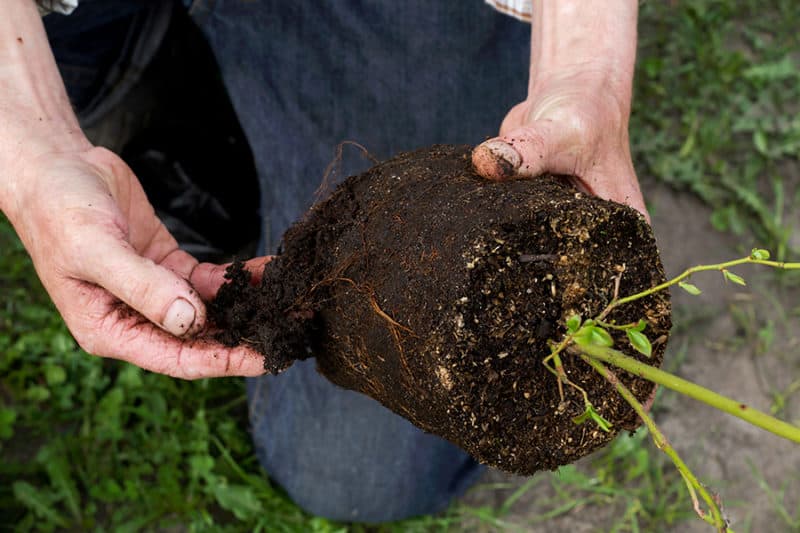
The easiest way is to plant either bare-roots or blueberry plants in containers. Bare-roots are the most inexpensive; you can find one between $5-10, depending on where you buy it.
Try to find plants or roots that are 2-3 years old. Any older and the plants will have transplant shock, extending the time until your first harvest.
When it’s time to plant your bushes, dig a hole that is 20 inches deep and 18 inches wide. Your hole needs to be around twice as wide and twice as deep as the roots of your plant.
In the bottom of the hole, put some peat moss, aged sawdust, compost, or other soil amendments to feed your bushes. Then, set your bush into the hole, spreading the roots out as evenly as you can.
Never put your bush any deeper than it was on the pot.
Once your bare-roots or potted bush is in the ground, tightly pack the hole with soil. Water deeply to help establish the roots in the ground.
Spacing
If you’re planting multiple bushes, space each bush 4-5 feet apart in a row, and put the rows 8 feet across.
Fertilize
The final step in planting your bushes comes a month after planting. You need to go back and add fertilizer to the base of the bush. Use a low dose of a 10-10-10 fertilizer.
Then, your job is finished for now, and you let the plant take over from there.
Can You Plant Blueberries in Containers?
Surprisingly, yes, you can grow blueberries in containers. It’s a fantastic idea, and for many gardeners, it’s easier to grow blueberries in containers because you can protect them from birds and other critters more easily.
You’ll want a large container, typically a 10-20 gallon pot, with drainage holes. Be sure that you use a potting soil that is designed for acid-loving plants, such as ones that are meant for azaleas.
Plant a variety that is meant for containers or small spaces. There are blueberries cultivated specifically for pots, so look for those.
Caring for Your Blueberries
Blueberry plants take a long time to produce a harvest. On average, it takes three years before you have even a small harvest. A full harvest takes up to six years, so you need patience.
Until then, you still need to take care of your bushes. Here is what you need to know.
How Much Water Do Blueberries Need?
Blueberries need 1-2 inches of water per week, at least. It’s best if the plants get a deep watering at least once a week. If you have a dry spell or hot weather, check the soil often to be sure it’s not too dry.
If you stick your finger into the soil and it’s dry beyond 1-inch, it’s time to water.
Blueberry bushes need one to two inches of water per week. This means if mother nature doesn’t provide it, then you’ll need to by consistently watering your plants.
Mulching Around The Bushes
It’s a good idea to mulch around the blueberry bushes because the mulch helps to keep the shallow root systems moist, decreasing how often you need to water each week.
Try putting a 2-4 inch layer of sawdust, pine needles, or woodchips around the base of your bush once you plant it. Leave a gap around the trunk of the bush because it allows for maximum airflow.
Fertilizing Blueberries
One month after planting your bushes, apply fertilizer. It’s best to use 1/2 ounce of a 10-10-10 fertilizer that you put in a circle around your plant. Keep the fertilizer 6-12 inches from the crown.
A year later, apply one ounce of 10-10-10 fertilizer per bush in the spring when it’s blooming time. Every year following, increase your fertilizer by one more ounce until you reach a maximum of eight ounces.
For example, in the third year, you’d be feeding your plant three ounces of fertilizer.
Pinch the Blossoms
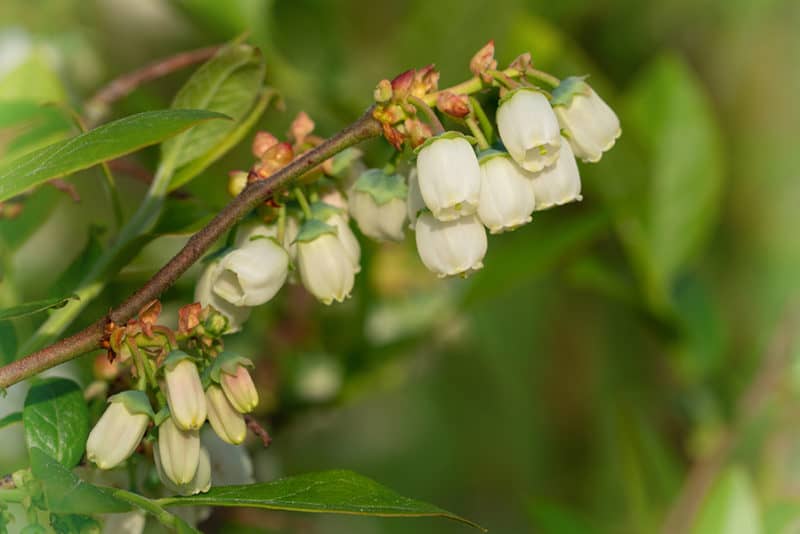
There’s no pruning needed in the first few years, but what you do need to do is remove any flowers that appear on the bushes. That’s a bit disheartening because you know that those flowers turn into fruits. However, it pays off because it leads to bigger, more vigorous bushes.
You don’t want your blueberry bushes to produce the first year or two in order to have a decent future harvest. You’ll want to pinch off any blooms on the blueberry bushes that you see.
How to Prune The Bushes
If you grow any other fruit bushes, such as raspberries, you know that pruning is part of the deal. For the first four years, you don’t need to prune blueberry bushes, which is awesome. That’s less work for you.
After the first four years, you do need to prune because it stimulates the growth of new shoots. Those new shoots will bear fruit in the following season, so if you want a harvest, you’ll have to get pruning.
The best time to prune your plants is in late winter or early spring, before new growth starts. Remove any dead, broken, short, weak, or strange-looking shoots.
If you have high-bush blueberries:
- Make large cuts, removing any wood that is 6 years old or crowding the center of the bush.
- Then, remove any low branches that might cause some fruit to touch the ground.
If you have lowbush blueberries:
- Cut all stems to the ground level.
- Since your plant will not bear fruit in the season after you pruned, you should only do half of a third of your blueberry patch to ensure you always have a harvest.
Common Problems with Blueberries
Every plant has its problems and blueberries are no different. Here are the issues they face:
Birds
Birds will often come along and snag your harvest before you have the chance. The solution to beating these pests is quite simple.
Purchase some bird netting and throw it over your blueberries. Then when you are ready to pick, you just remove the netting while picking and put it back when done.
Blueberry Maggots
The next pest on the list is blueberry maggots. Flies lay the eggs of their offspring in newly starting blueberries. Then, as the blueberries grow, so do the maggots inside them. This doesn’t harm the plant, but it does ruin your harvest.
The solution is either spraying your plants with a pesticide to deter flies, or to choose varieties that make it difficult for bugs to lay their eggs. Cultivars like Northland and Herbert are good options.
Powdery Mildew
Powdery mildew is a fungus that looks like powder has been thrown all over your blueberry bushes. The only way to rid yourself of this fungus is to use a targeted fungicide or to remove the infected parts of the plants.
Best Companion Plants for Blueberries
There are some plants that do better when planted near one another. Blueberries don’t have many of these plants, but they do have a few. Here they are:
Rhododendron
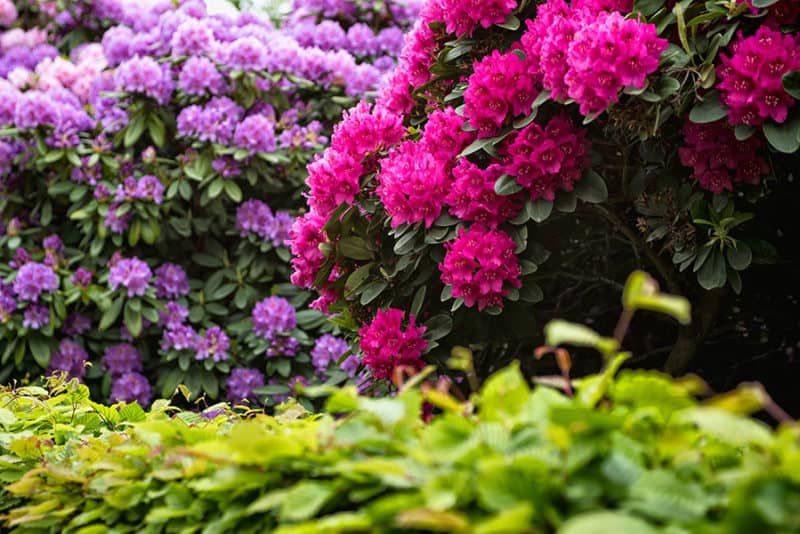
These beautiful flowers have a way of providing just enough shade to the blueberry roots that it protects them from the heat during the summer. Both blueberries and rhododendrons like acid soil.
Basil

Basil can grow in slightly acidic soil, making it a good companion for blueberries.
Also, because blueberries are shorter plants they don’t put the fruit of the blueberry bush in too much shade.
Thyme
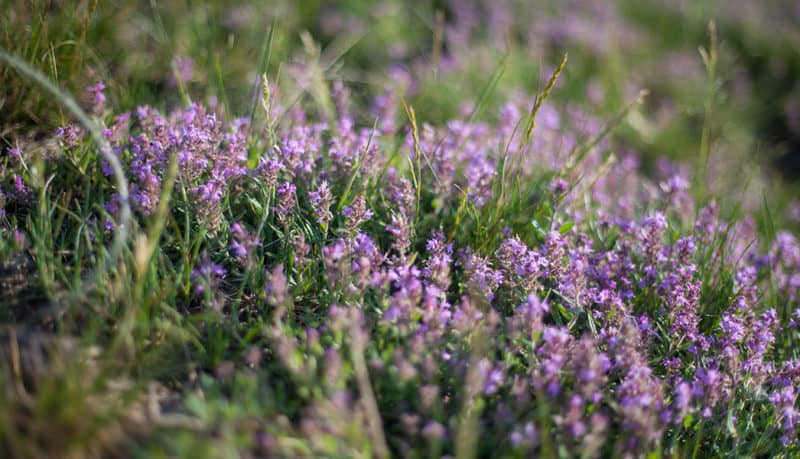
Thyme is like basil. It can grow in acidic soil, and it’s short, which means it doesn’t stop the bush from getting the sunlight it needs to produce the desired fruits.
How to Harvest and Store Your Blueberries
Most blueberries are ready to harvest between June and August. You don’t need to harvest them as soon as they turn blue; wait a few days. When the berries fall into your hands, they’re ready.
How and When to Harvest
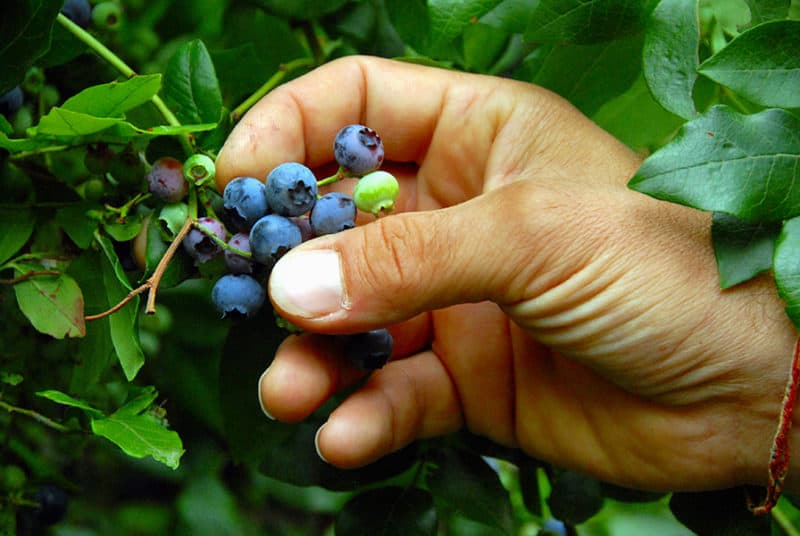
When your blueberries turn a dark blue you’ll know they are ready for picking.
Then you’ll use a small bucket to walk around your blueberry patch and collect the blueberries. There isn’t much to picking them because when they are ready, they’ll easily fall off into your hand.
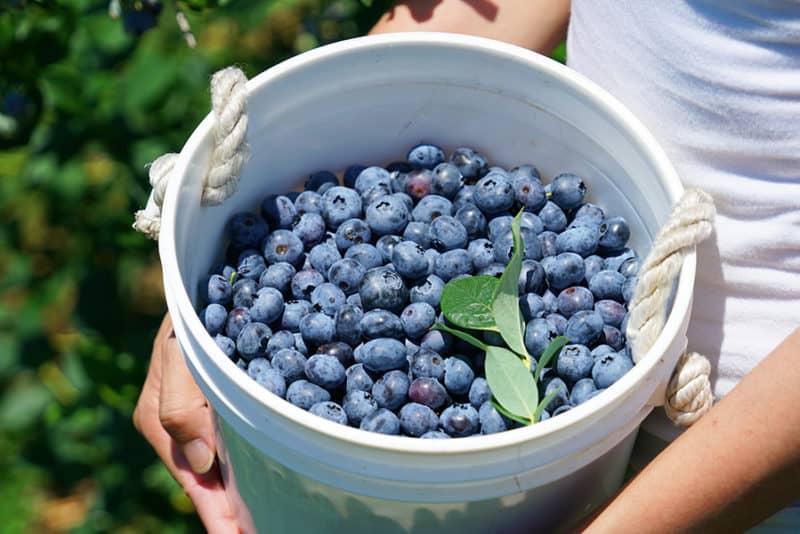
Wash Them
Once you have them picked, you are ready to bring your blueberries in and wash them. Run them under cold water to remove all of the dirt.
Pick Your Preservation Method
Of course, they’re delicious fresh or as a topping for desserts, yogurt, granola, or pancakes. But you can preserve blueberries so you can enjoy them all year long.
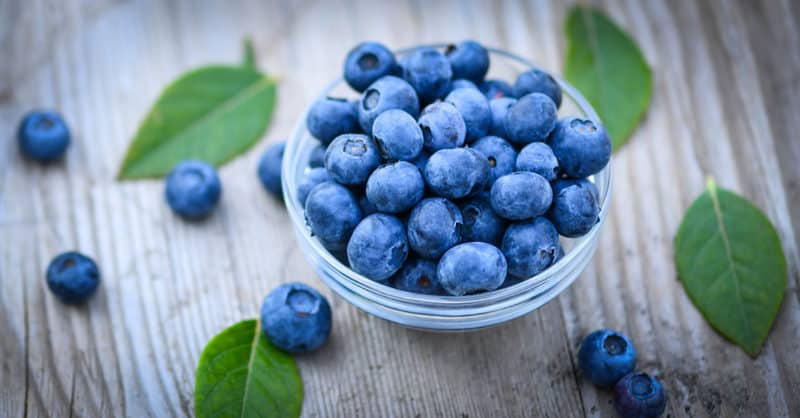
Then you can run down the list of the 8 different methods of preserving your blueberry harvest and see which method you prefer. They vary between freezing, canning, drying, making a syrup, and so much more.
Blueberries Are Worth the Effort
If you’ve been intimidated to try out growing blueberries, don’t be. You’re now armed with the information you need to make these plants thrive.
We’d love to hear about your successes with growing blueberries. Be sure to share your experiences in the comments.

